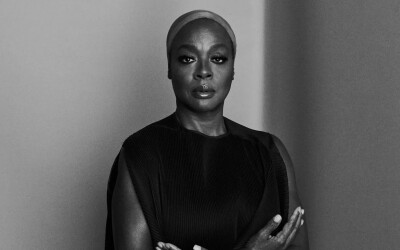A book published by MIT Press features essays and reflections
In “Mourning,” a black and white photograph from artist Carrie Mae Weems’s 2008 series Constructing History, two women dressed in black sit next to each other on wooden chairs. Their expressions are solemn. A young child, dressed in a glowing white dress, crouches near on the floor, her arms and head positioned to rest on one of the women’s laps. They sit on a white pedestal. It could be a family portrait, though the scene is made odd by their surroundings. A camera track circles the platform like a mote, while a dolly with a tripod and camera appears to the right, in the middle of capturing the three figures in its slow 360-degree orbit. We’ve stumbled upon a set, one that mixes performance and longing, fact and fiction, in ways that deconstruct the stories we tell about ourselves.
“Constructing History has so much to do with the orchestrations of reality in a very particular kind of way. That becomes the center to the kind of work that I am most interested in,” Weems explained to African American studies and art history professor Sarah Elizabeth Lewis and Studio Museum in Harlem Director Thelma Golden. Their conversation appears in Carrie Mae Weems, the latest volume of MIT Press’s October Files, a series that surveys individual artists through a compendium of essential essays about their work. Edited by Lewis with Christine Garnier, Carrie Mae Weems brings together essays by bell hooks, Deborah Willis, and Kimberly Juanita Brown, alongside poetic reflections by Dawoud Bey, Salamishah Tillet, and others. Sprinkled throughout are images from Weems’s most enduring series — The Kitchen Table Series (1990), From Here I Saw What Happened and I Cried (1995–1996), Roaming (2006) — that provide a glimpse of her elegant and analytical style.
We experience Weems and the monumentality of her work through others’ encounters with her photographs, texts, performances, videos, and installations. In her 1994 essay “Diasporic Landscapes of Longing,” hooks considers Weems’s work in the context of Roy DeCarava, writing how Weems both picks up his project of “claim[ing] Blackness as the aesthetic space of ethereal beauty,” while also going beyond his legacy to critically look at photography as a tool of domination and erasure. Most essays echo this point — how Weems’s restaging of African diasporic experience doubles as an incisive breakdown of Western visual culture and history. Using her body and subjectivity as guide and witness, Weems rejects the two dimensionality of the photographic form, instead constructing emotionally charged landscapes where we can consider the shifting expressions of power, beauty, history, love, and invention.
Considered one of the most influential contemporary American artists, Carrie Mae Weems has investigated family relationships, cultural identity, sexism, class, political systems, and the consequences of power. Determined as ever to enter the picture—both literally and metaphorically—Weems has sustained an on-going dialogue within contemporary discourse for over thirty years. During this time, Carrie Mae Weems has developed a complex body of art employing photographs, text, fabric, audio, digital images, installation, and video.In a New York Times review of her retrospective, Holland Cotter wrote, “Ms. Weems is what she has always been, a superb image maker and a moral force, focused and irrepressible.”
Weems has participated in numerous solo and group exhibitions at major national and international museums including the Metropolitan Museum of Art, The Frist Center for Visual Art, Solomon Guggenheim Museum in New York, and the Centro Andaluz de Arte Contemporáneo in Seville, Spain.





